Transform Your Kitchen: The Ultimate Guide to Kitchen Island Posts and Design
Kitchen islands with posts have become an indispensable feature in contemporary home designs, offering a perfect blend of practicality and stunning aesthetics. More than just structural elements, these posts are thoughtfully designed features that combine essential support with attractive style. They provide an opportunity to elevate your kitchen’s design, making them a worthwhile consideration for any home renovation or kitchen update.
This comprehensive guide will explore how to maximize the potential of kitchen island posts, whether they are structural necessities or purely decorative additions. We’ll delve into everything from selecting the ideal post style and material to practical advice on placement, integration, and long-term maintenance. By the end, you’ll have a clear understanding of how posts can elegantly solve common kitchen design challenges, significantly enhancing your space’s visual appeal and becoming standout features that truly reflect your personal style.
Why Choose a Kitchen Island with Posts? Blending Style and Functionality
Kitchen islands with posts offer a unique advantage by seamlessly blending vital structural support with distinctive design elements. In open-plan living spaces, where a large island might serve multiple purposes, posts provide crucial stability and a sense of permanence. Instead of attempting to conceal necessary structural components, integrating them into your island design transforms a functional requirement into an attractive focal point, adding depth and character to your kitchen.
The versatility of these posts is remarkable, allowing them to complement a vast array of interior design themes. Imagine the rustic charm of robust wooden columns in a farmhouse kitchen, evoking a sense of heritage and warmth. Or picture the sleek, minimalist appeal of polished metal supports in a modern, industrial-inspired setting. These elements can be customized to match or contrast with existing cabinetry and décor, making them adaptable to virtually any aesthetic.
Beyond their visual appeal and structural benefits, kitchen island posts often incorporate ingenious practical features. Many designs include built-in storage solutions, such as elegant wine racks for the connoisseur, discrete shelving for cookbooks, or convenient hooks for hanging frequently used utensils, keeping your workspace tidy and efficient. Some posts can even integrate electrical outlets, providing a convenient charging station for devices or a power source for small appliances, further enhancing the island’s utility. Crucially, for those opting for luxurious heavy stone countertops like granite or marble, posts offer the essential support needed to prevent sagging or cracking over time, ensuring the longevity and safety of your investment.
Thoughtfully integrating posts into your kitchen island allows you to craft a distinctive, custom look. This approach not only solves practical problems related to support and storage but also significantly enhances the overall ambiance and efficiency of your culinary space, making it a true hub of your home.
Applications of Kitchen Island Posts in Modern Design
Posts serve as the fundamental backbone for many larger kitchen islands, particularly those designed for extensive use and entertaining. They enable the creation of bigger, more functional work surfaces without compromising stability or risking issues like sagging. This structural integrity is particularly vital when incorporating natural stone countertops, which are inherently heavy and require robust, evenly distributed support to prevent long-term damage.
Beyond their foundational role, well-designed posts are powerful tools for creating visual interest and defining zones within an open-plan kitchen. They can elegantly mark the transition between the food preparation area and a casual dining or entertaining space. For instance, a pair of distinct posts can frame a breakfast bar, clearly separating it from the main cooking zone. Decorative posts inherently draw the eye, serving as conversation starters and imparting a sense of thoughtful design and bespoke craftsmanship to your kitchen. They transform a purely functional space into one that feels more welcoming, organized, and aesthetically considered.
Classic vs. Modern Designs of Kitchen Island Posts
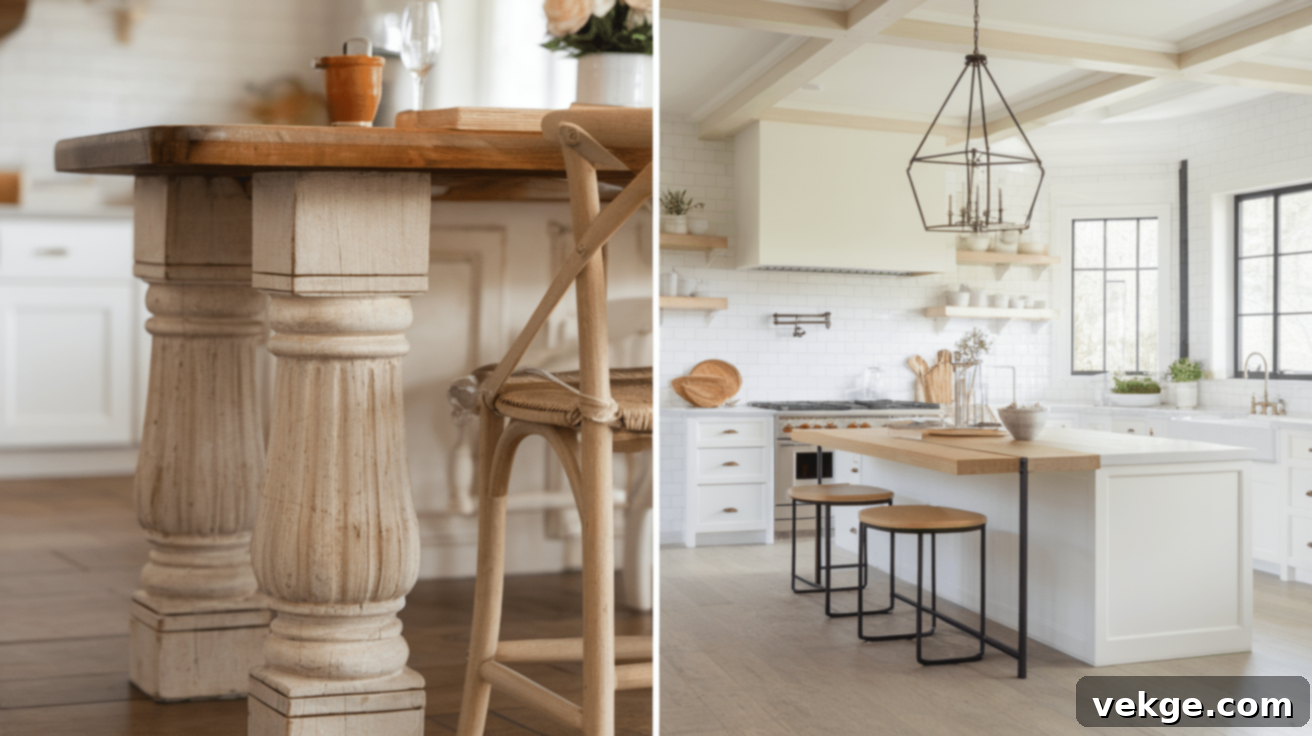
The style of post you select for your kitchen island plays a pivotal role in setting the overarching tone for your entire kitchen design. With a multitude of options available, choosing the right style involves a careful consideration of both aesthetic appeal and practical functionality, ensuring it harmonizes with your kitchen’s layout and intended uses. Kitchen island post styles generally fall into two broad categories: traditional and contemporary. Each offers a distinct look and feel that can profoundly influence the overall atmosphere of your kitchen.
| Design Type | Key Features | Best For | Visual Impact |
|---|---|---|---|
| Traditional Posts | Columns with detailed carving, turned wood with graceful curves, fluted designs, often with intricate bases and capitals. | Farmhouse, country, rustic, classic, Victorian, and Mediterranean kitchen styles. | Creates a warm, homey, and inviting feeling with an emphasis on handcrafted details and historical elegance. Adds a sense of gravitas and timeless beauty. |
| Contemporary Posts | Clean lines, simple geometric shapes (square, rectangular), often made from metal or wood with minimal ornamentation. Integrated flush designs. | Modern, industrial, minimalist, Scandinavian, and open-plan kitchens. | Offers a clean, simple, and sophisticated look that often blends seamlessly into the architecture rather than overtly standing out. Contributes to a spacious and uncluttered aesthetic. |
When making your selection, consider how the posts will interact with other elements in your kitchen, such as cabinetry, countertops, and flooring. A traditional kitchen might benefit from the ornate details of a turned wood post, adding to its artisanal charm, while a modern kitchen could be enhanced by the stark simplicity of a brushed stainless steel post, reinforcing its contemporary edge.
Kitchen Island Support Posts: A Comprehensive Material Guide
The material choice for your kitchen island support posts is a critical decision that significantly impacts both its functionality and overall aesthetic appeal. These posts are not merely structural components; they are design elements that can dramatically elevate your kitchen’s style, tying together the various aspects of your home renovation project. This section explores various material options, providing insights to help you make an informed decision.
1. Wood Posts: Timeless Warmth and Versatility

Wood posts inherently introduce warmth, natural texture, and a sense of organic beauty to kitchen islands. The selection of wood types offers immense versatility: durable options like oak and maple provide longevity and can be stained in various hues, while walnut delivers rich, deep colors that exude sophistication. Many homeowners opt for wood posts that perfectly match their existing cabinetry, creating a cohesive and beautifully integrated look throughout the kitchen. For those seeking unique character, reclaimed wood posts offer a narrative of history, featuring distinctive marks and textures that tell a story, adding an unparalleled rustic or industrial charm to your space. Wood posts are highly customizable in terms of carvings, turnings, and finishes, making them adaptable to almost any traditional or transitional kitchen style.
2. Metal Posts: Sleek, Modern, and Durable
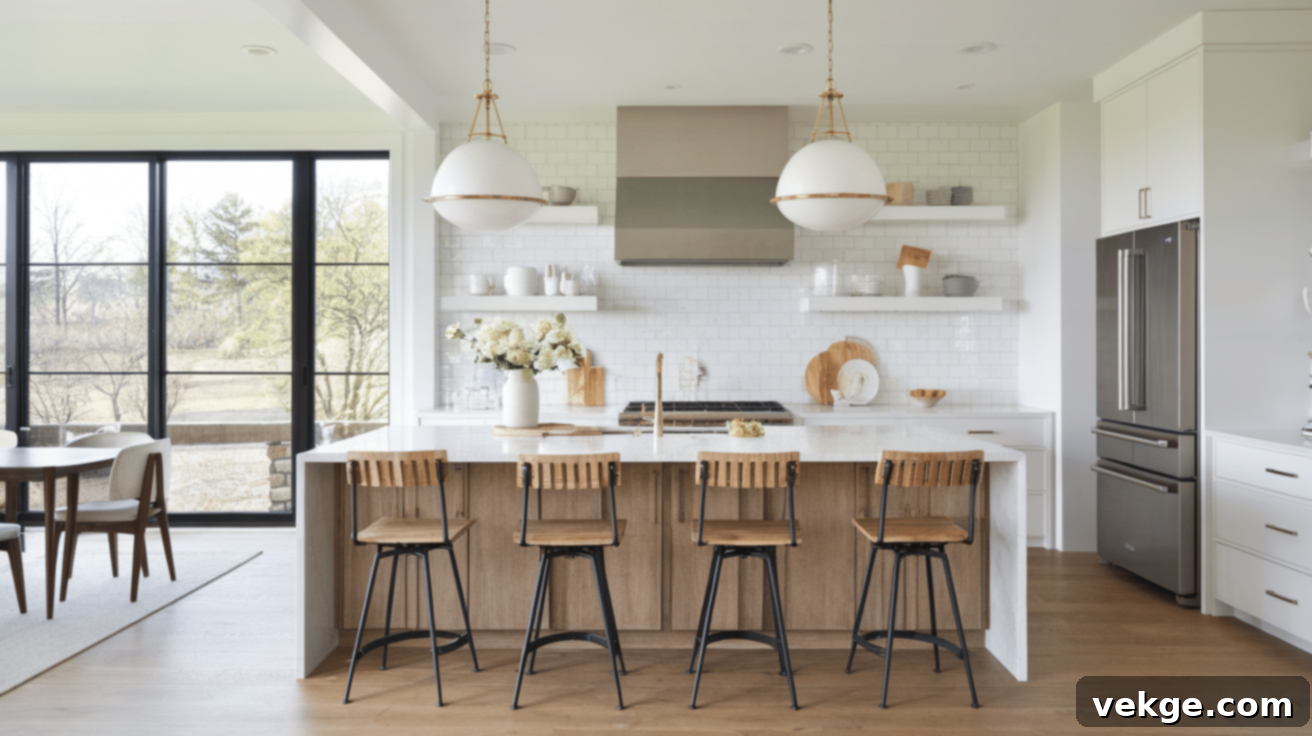
Metal posts are the epitome of crisp, clean lines and modern elegance, making them an excellent choice for contemporary and industrial kitchen styles. Materials like stainless steel provide a professional, sleek finish; brushed nickel offers a softer, more refined look; and matte black metal creates a dramatic, minimalist statement. A key advantage of metal posts is their ability to occupy less visual space compared to their wooden counterparts, making them an ideal solution for smaller kitchens where maintaining an open, airy feel is paramount. Metal’s inherent strength and resistance to moisture and wear also make it a highly durable and low-maintenance option for a busy kitchen environment.
3. Stone/Granite Posts: Luxurious Strength and Statement
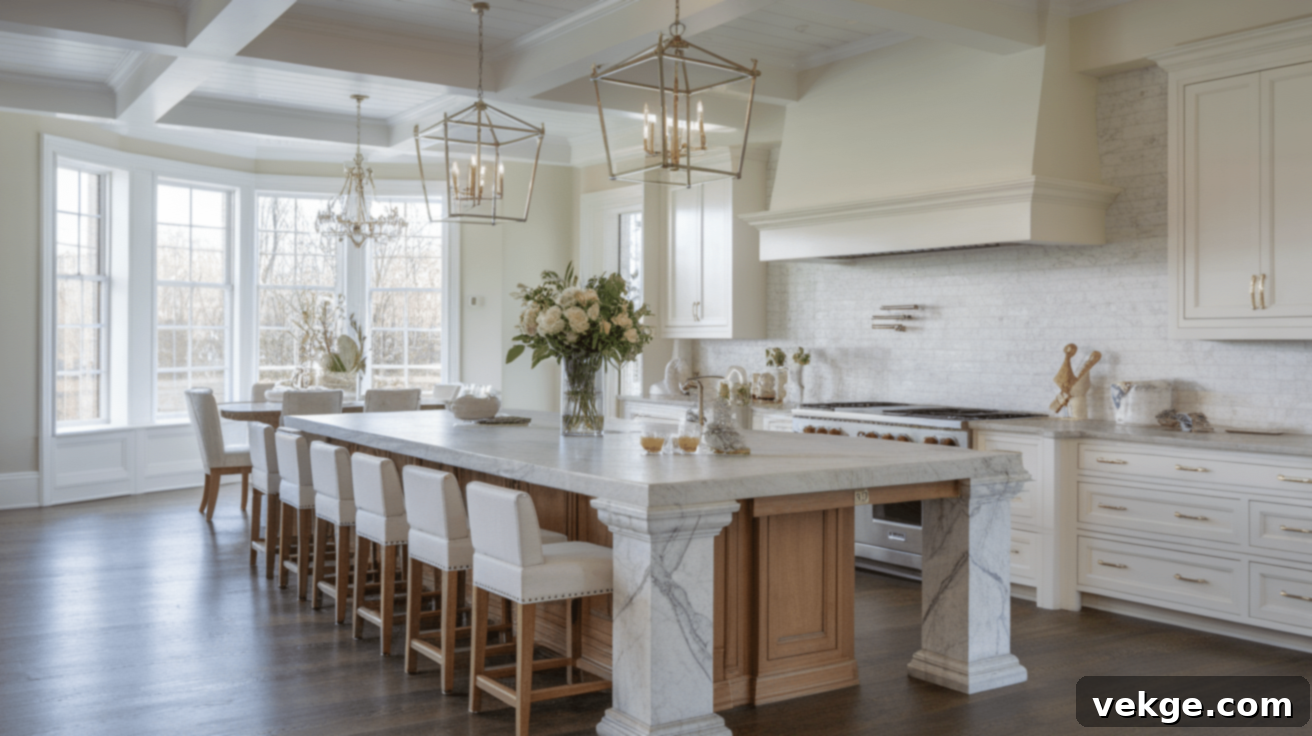
For truly bespoke and high-end kitchens, stone posts, particularly those crafted from granite or marble, offer an unparalleled blend of natural beauty and robust strength. While typically a more significant investment than wood or metal, stone posts create an undeniably luxurious and sophisticated aesthetic, especially when paired with matching stone countertops. These posts act as magnificent statement pieces, showcasing meticulous attention to detail and an appreciation for premium materials in kitchen design. Their substantial presence adds a grand architectural element, making the kitchen feel more established and opulent. Regular sealing is essential to maintain their pristine appearance and protect against stains.
Post Styles for Enhanced Function and Beauty
When meticulously designing a kitchen island, the specific support posts you select are crucial, profoundly influencing both the structural integrity and the overall aesthetic appeal of the space. These essential elements transcend mere functionality, seamlessly blending form and purpose to serve as both critical architectural supports and striking design statements within your kitchen’s landscape.
1. Square Posts: Modern Simplicity and Strength
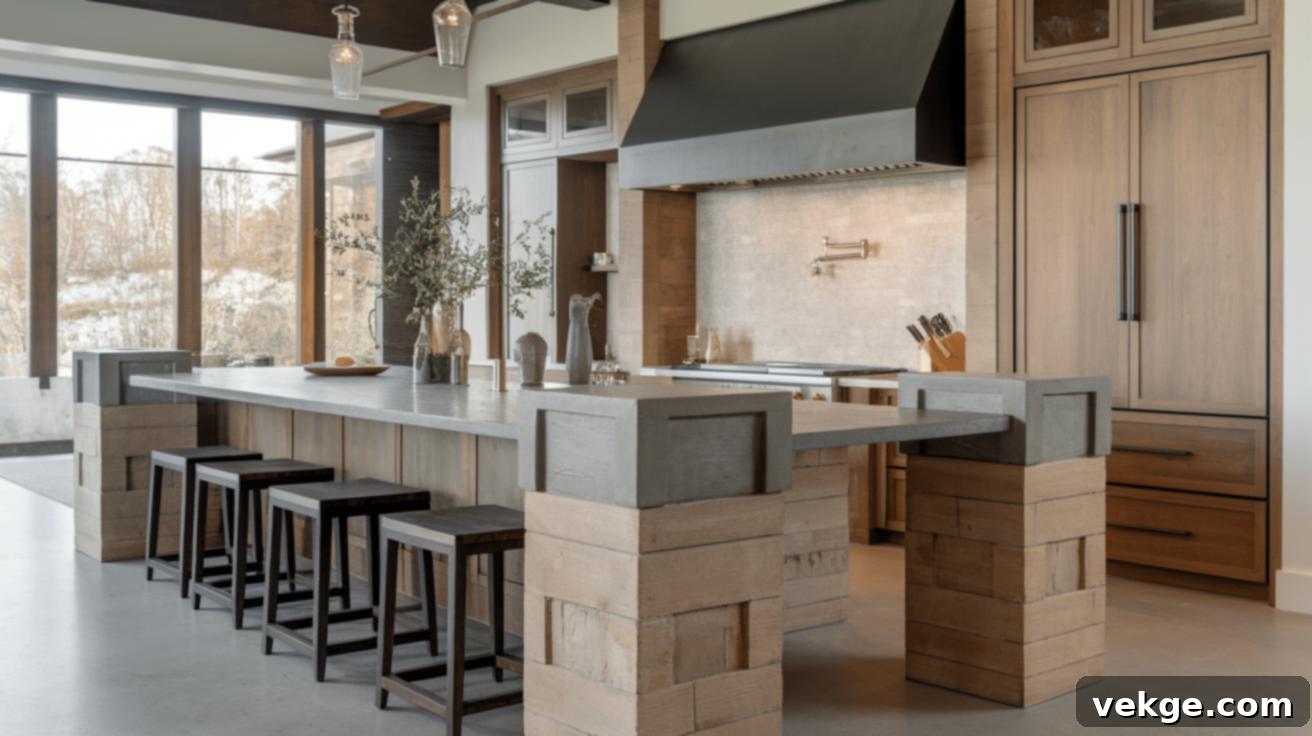
Square posts convey a sense of unyielding strength and steady presence, fitting effortlessly into contemporary and modern kitchen designs. Their clean, straight lines align perfectly with the streamlined aesthetics of modern cabinetry and sleek appliances. This style is incredibly versatile, as square posts can be fashioned from virtually any material – whether it’s wood for a touch of organic warmth, metal for a more industrial edge, or even clad in custom panels to match surrounding finishes. Their geometric simplicity makes them a timeless choice that doesn’t overpower the design but rather enhances it with understated elegance.
2. Round Columns: Classic Elegance and Timeless Appeal
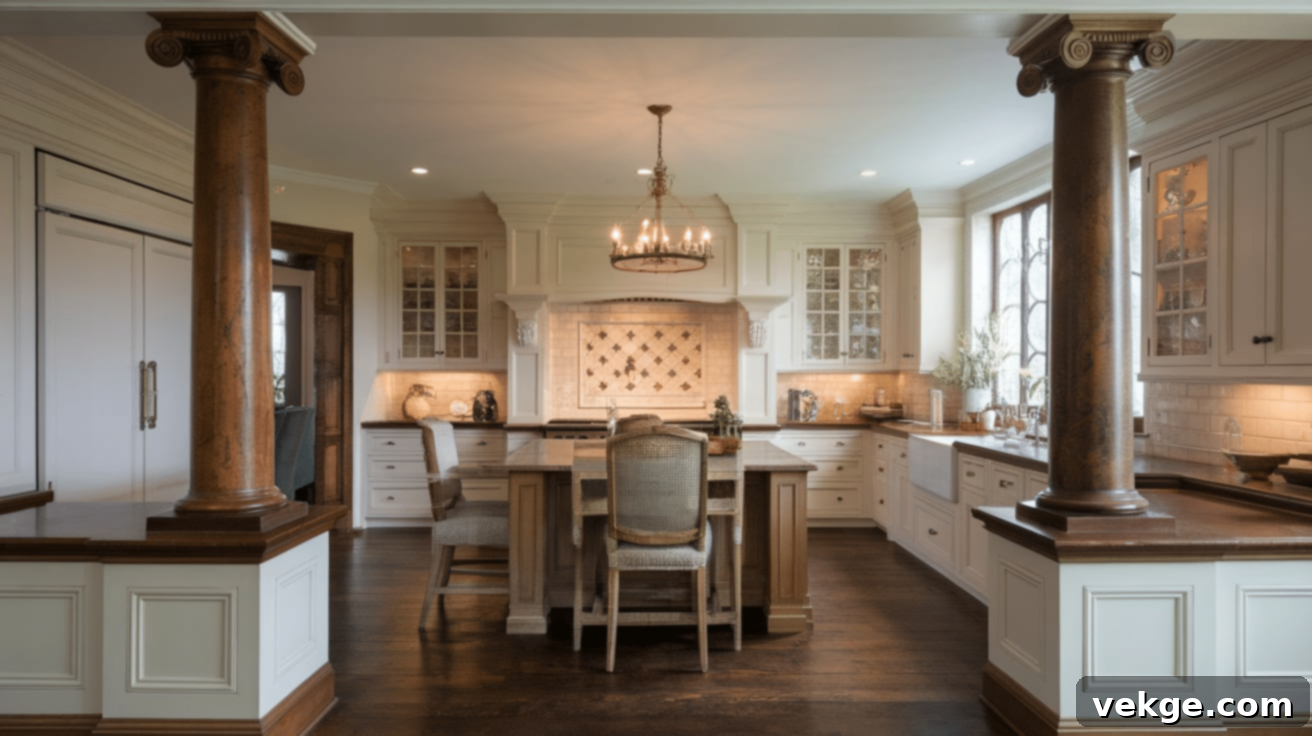
Round columns infuse a classic, timeless quality into kitchen islands, often reminiscent of traditional architectural elements. These posts frequently feature intricate details near their top (capitals) and bottom (bases), similar to historical building columns, adding a touch of grandeur. This style is particularly well-suited for traditional, classical, or even transitional homes where other architectural details, such as doorways, molding, or furniture, incorporate curved or rounded elements. Round columns soften the hard edges of a kitchen, introducing a graceful flow and a sense of refined sophistication.
3. Corner Posts: Defining Spaces and Subtle Support
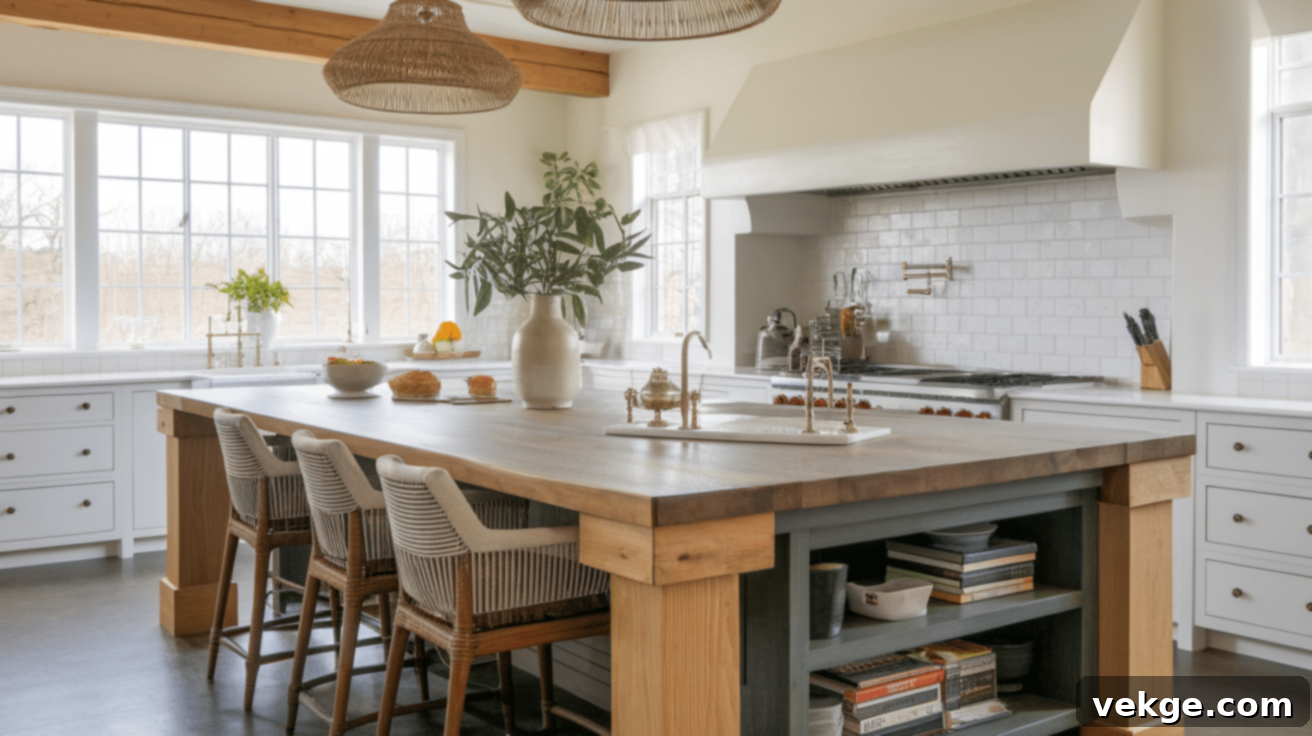
Corner posts are strategically positioned at the edges of kitchen islands, expertly defining boundaries while providing essential support. While often slightly more slender than central support posts, they effectively perform their structural role without overwhelming the visual space. Corner posts are particularly effective in larger islands where there’s a desire to delineate different functional zones, such as separating a dedicated cooking or prep area from an informal dining or entertainment space. They offer a neat, finished look, making the island appear thoughtfully designed and integrated into the room’s architecture.
How to Integrate Posts into Your Kitchen Island Design for Optimal Flow
Successfully integrating posts into your kitchen island design demands a thoughtful balance between aesthetic appeal and practical functionality. A meticulously placed post can transcend its role as a mere support structure, becoming a pivotal design element that enhances both the beauty and efficiency of your kitchen. With careful planning, posts can elevate your kitchen’s style while flawlessly serving their essential structural purpose.
Choosing the Right Location for Kitchen Island Posts
The optimal placement for your island posts is largely dictated by your kitchen’s overall layout, the size of your island, and how you intend to utilize the space. Corner posts are an excellent choice for clearly defining the perimeter of an island while strategically staying out of the primary pathways of daily kitchen tasks. For longer islands, edge posts can skillfully divide distinct zones, separating areas designated for cooking and preparation from those used for dining or casual gathering. In the case of exceptionally large islands that require extensive support, central posts become a logical necessity, ensuring stability across the expansive surface.
When deciding on post placement, it is paramount to consider the natural flow of movement within your kitchen. A poorly positioned post can inadvertently obstruct the critical “working triangle” – the path between your stove, sink, and refrigerator – which is the heart of any functional kitchen. Before finalizing your design, it’s highly advisable to physically walk through your proposed layout. Simulate daily activities to confirm that posts do not create constricted passages or awkward corners that could impede movement or become problematic in the long run. Good design prioritizes effortless navigation and efficient workflow.
Making the Post Part of Your Overall Design Scheme
If your kitchen island includes seating, the placement of posts requires careful consideration to ensure comfort and maximize legroom. Ideally, posts should be set back slightly from the edge where chairs or stools will be positioned, or strategically used to define the ends of a seating area. This thoughtful approach ensures that the posts fulfill their structural role without infringing on the comfort of those seated at the island, keeping the space under the counter clear for legs and stools.
For a seamless, built-in aesthetic, consider how posts can be harmoniously integrated with your existing cabinetry. Posts can be expertly “boxed in” with matching cabinet panels, making them appear as an original, integral part of the island’s construction rather than an add-on. Another sophisticated approach involves using half-wall designs, where posts are partly encased within a wall and partly extended into the island. This method cleverly conceals the structural components while maintaining the visual appeal of the post design, resulting in a smooth, custom-finished look that elevates the entire kitchen’s design integrity.
Popular Kitchen Island Post Designs and Inspirations
Kitchen island posts are available in a diverse range of styles, designed to perfectly suit various spaces, functional needs, and aesthetic preferences. Here are some of the most common and inspiring designs that homeowners frequently choose to enhance their kitchens.
Kitchen Island with Post and Seating: A Functional Divider
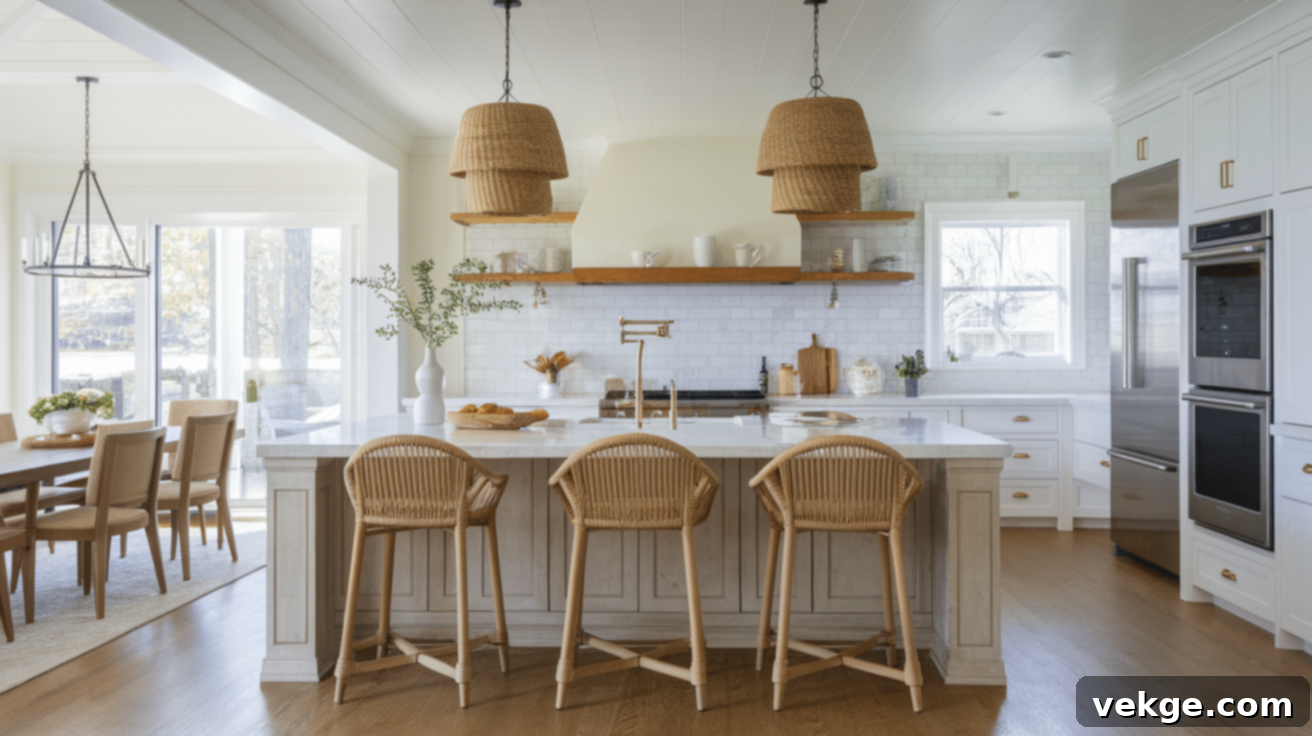
Posts are exceptionally well-suited for framing and supporting seating areas on kitchen islands. Strategically placed at the ends or along the perimeter of the seating zone, they provide robust support without obstructing the space needed for people to comfortably sit at the island. This design ensures that the area beneath the counter remains open and accommodating for legs and stools, while still delivering essential structural stability to the countertop above.
Beyond structural support, posts can serve as natural and elegant visual dividers between the more active cooking and prep zones and the more relaxed dining or entertainment areas. When positioned between these distinct spaces, they create a subtle yet effective visual break, helping each area feel like it has its own defined purpose. This is particularly advantageous in busy family kitchens or open-plan layouts where distinct zones are beneficial for both functionality and organization, contributing to a more harmonious and efficient kitchen environment.
Small Kitchen Island with Post: Maximizing Space and Utility
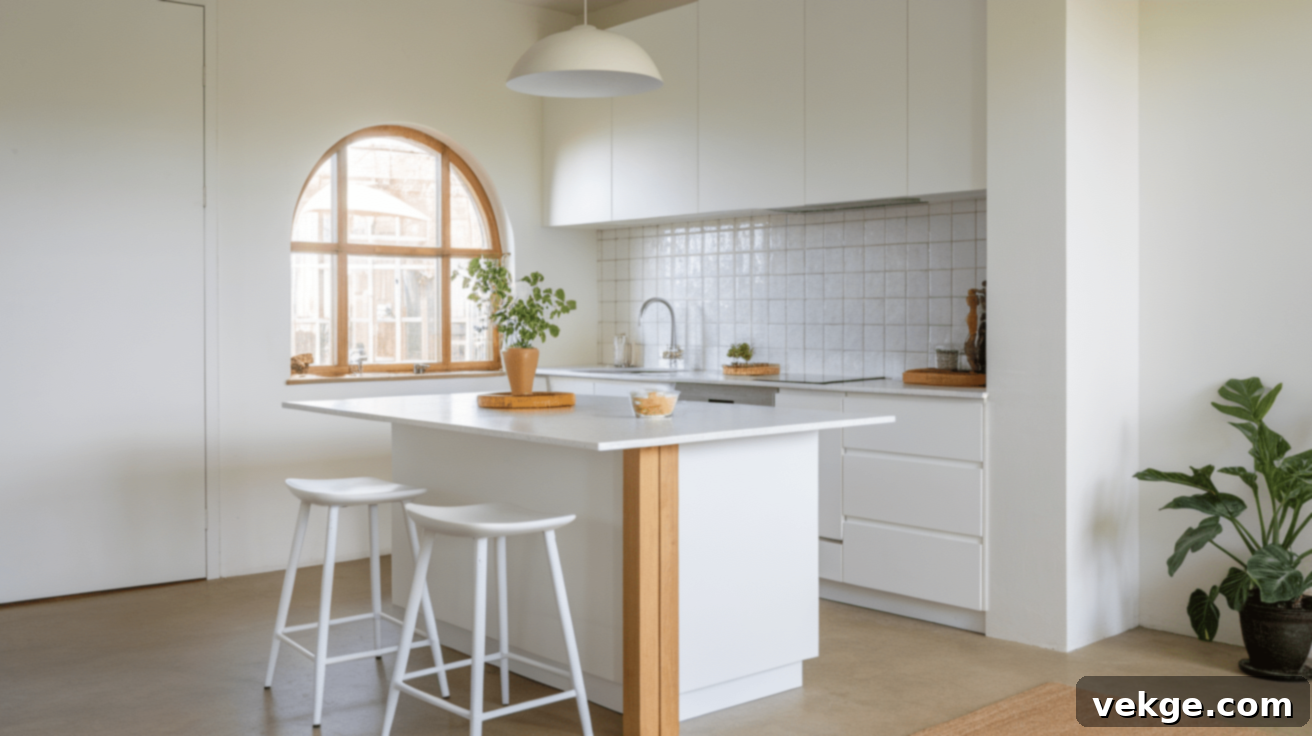
In kitchens where space is a premium, thinner or more strategically placed posts are invaluable. They offer the necessary support while minimizing visual bulk, preventing the kitchen from feeling cramped. For very compact layouts, considering a single, elegant post at one corner or end of the island, rather than multiple posts, can provide adequate support without overwhelming the space. This approach keeps the visual footprint light and airy.
Posts in small kitchens can be designed for multi-purpose functionality, turning a simple support element into a helpful kitchen asset. For instance, they can incorporate integrated hooks for hanging tea towels or oven mitts, discreet built-in electrical outlets for small appliances, or slim, vertical shelving for a few treasured cookbooks or decorative items. These clever features transform a basic support need into a smart, space-saving, and highly useful element, proving that even small kitchens can benefit greatly from well-designed posts.
Kitchen Island with Post to Ceiling: A Grand Architectural Statement
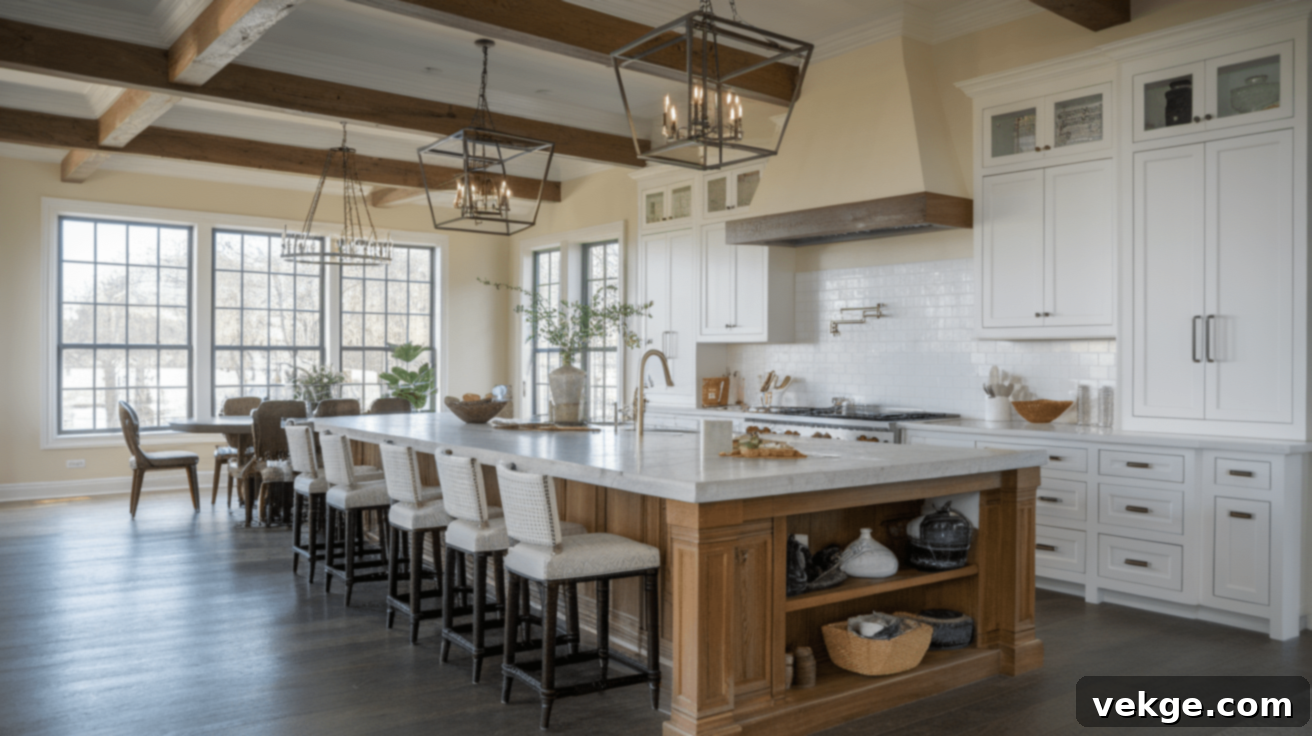
Extending posts from the kitchen island all the way to the ceiling creates a dramatic and strong visual statement, particularly impressive in kitchens with higher ceilings (typically 9 feet or more). This architectural design naturally draws the eye upward, enhancing the perceived height of the room and making the entire space feel significantly larger and more open. Full-height posts offer substantial structural benefits, providing robust support not only for the island itself but potentially also contributing to the ceiling structure above.
To ensure a balanced and cohesive aesthetic, it is often advisable to match the material and finish of your full-height posts to other architectural woodwork in the room, such as crown molding, exposed ceiling beams, or door frames. This creates a unified and thoughtfully designed look. Beyond pure support, these posts can also integrate custom features like integrated lighting, display shelves for art or decorative pieces, or even act as a subtle room divider, adding layers of sophistication and functionality to your kitchen design.
Materials and Finishes for Your Kitchen Island Posts: An In-Depth Look
The selection of materials and finishes for your kitchen island posts is a pivotal design decision that profoundly impacts both the aesthetic appeal and the long-term durability of your kitchen. These choices are not merely decorative; they influence the overall character, maintenance requirements, and longevity of your island, making them essential considerations in any renovation project.
Selecting the Best Materials for Durability and Style
The material selection process requires a careful balance between your personal aesthetic preferences and practical considerations, such as your kitchen’s existing design elements and your family’s lifestyle needs. Each material offers a unique set of properties that affect not only its appearance but also its longevity, specific maintenance requirements, and overall performance within the high-traffic, often demanding environment of a kitchen.
| Feature | Wood Posts | Metal Posts | Stone Posts |
|---|---|---|---|
| Look & Feel | Warm, natural, traditional, rustic, versatile in stain/paint. | Cool, sleek, modern, industrial, professional, minimalist. | Luxurious, grand, natural, unique patterns, high-end. |
| Cost Range | Mid-range for standard hardwoods (oak, maple), higher for exotic woods or intricate carvings. | Generally higher than wood, especially for custom designs, specialty metals (e.g., copper), or intricate fabrication. | Highest cost, reflects natural material and specialized installation. |
| Durability | Good with proper sealing/finishing; susceptible to scratches/dents; can warp if exposed to excessive moisture. | Excellent, highly resistant to damage, moisture, and pests; very long-lasting. | Exceptional, extremely hard-wearing, heat and scratch resistant (granite); can chip. Requires sealing for porous stones (marble). |
| Maintenance | Needs regular cleaning, occasional waxing/polishing, and periodic re-sealing/refinishing. | Simple cleaning with a damp cloth; stainless steel cleaners for shine; virtually no specialized treatments. | Specific cleaning products (pH neutral), annual sealing for porous types, prompt spill cleanup. |
| Weight | Lighter than metal or stone, generally easier to install. | Heavier than wood, especially solid options; may require robust floor support depending on design. | Heaviest option, absolutely requires substantial floor support and professional installation. |
| Best Kitchen Styles | Farmhouse, country, traditional, craftsman, rustic, transitional, Shaker. | Industrial, contemporary, modern, minimalist, urban, Scandinavian. | Luxury, classic, Mediterranean, high-end traditional, grand contemporary. |
While wood offers a timeless charm and incredible customization, it typically demands more care over time to maintain its pristine condition. Metal, on the other hand, provides enduring durability with minimal maintenance, perfectly suiting a busy, modern lifestyle. Stone posts offer unparalleled luxury and strength but come with a higher initial investment and specific care requirements. For most kitchens, the ideal choice ultimately comes down to which material best complements your existing cabinets, countertops, flooring, and overall home style, ensuring a cohesive and functional design.
Color and Texture Tips for Kitchen Island Posts
When selecting the colors and textures for your kitchen island posts, the primary goal should be to achieve harmony with your existing kitchen elements. Many homeowners find success in matching their posts directly to their cabinetry for a seamlessly cohesive and integrated appearance. Alternatively, coordinating the posts with the island’s color, especially if it differs from the main kitchen cabinetry, can create a striking yet balanced look. For optimal results, aim to select a post color that effectively complements at least two of your major kitchen elements – be it cabinets, countertops, or flooring – to ensure visual unity.
For those daring to make a bolder statement, contrasting colors can create exceptionally striking design features. Imagine dark-stained wood or matte black metal posts set against crisp, light-colored cabinets; this combination creates a dramatic focal point and a sense of sophisticated contrast. Conversely, crisp white posts against dark cabinetry can introduce a fresh, bright, and airy effect. To ensure this contrasting approach works effectively and feels intentional, it’s beneficial to echo the contrasting color in other kitchen elements, such as light fixtures, cabinet hardware, or small appliances. This repetition ties the design together, transforming a potential clash into a beautifully orchestrated and dynamic aesthetic.
Maintenance Tips for Kitchen Island Posts: Ensuring Longevity and Beauty
Regular and diligent care is essential to ensure that your kitchen island posts maintain their beauty, structural integrity, and lustrous finish for many years to come. Simple, consistent maintenance routines are your best defense against the spills, heat, moisture, and daily impacts that are common in any busy kitchen environment. Tailoring your cleaning approach to the specific material of your posts will maximize their lifespan and preserve their aesthetic appeal.
- For Wood Posts:
- Clean weekly using a soft, slightly damp cloth moistened with a mild soap solution. Always dry immediately to prevent water damage.
- Apply furniture wax or a specialized wood polish every 3-6 months to nourish the wood, enhance its luster, and provide a protective barrier.
- Re-seal wooden posts annually with a clear polyurethane or a wood-specific sealant to guard against moisture penetration and wear.
- Address any small scratches or nicks promptly using a matching wood marker or furniture crayon to minimize their visibility.
- For Metal Posts (Stainless Steel, Brushed Nickel, etc.):
- Dust metal posts weekly with a soft, damp cloth to remove fingerprints, dust, and light smudges.
- For a deeper clean and to restore shine, use a specialized stainless steel cleaner or a mild glass cleaner monthly. Always wipe in the direction of the grain for brushed finishes.
- Avoid abrasive cleaners or scouring pads, as these can scratch the finish.
- For Stone Posts (Granite, Marble, Quartz):
- Clean stone posts exclusively with stone-specific, pH-neutral cleaning products to avoid damaging the surface or stripping the sealant.
- Apply a high-quality stone sealer yearly (or as recommended by the manufacturer) to granite or marble posts to prevent staining and enhance their natural resistance.
- Always use coasters and trivets near stone posts, especially if they are part of a counter extension, to protect against heat damage and condensation rings.
- Wipe spills immediately, particularly acidic liquids like lemon juice or wine, to prevent etching or staining.
Conclusion: Elevate Your Kitchen with Thoughtfully Designed Island Posts
Kitchen islands featuring posts offer a sophisticated and smart amalgamation of aesthetic appeal and purposeful functionality for today’s homes. They adeptly address practical design challenges while simultaneously infusing charm, character, and an elevated sense of style into your culinary space. The judicious selection of the right post can transform a simple island into a standout kitchen feature, one that perfectly aligns with and enhances your unique design preferences.
As you embark on planning your next kitchen update or renovation, we encourage you to thoughtfully consider how posts might integrate into your space. Their versatility allows them to be anything from a subtle, cost-effective structural element to the undeniable centerpiece of your kitchen’s entire design. Take the necessary time to explore the diverse range of styles, materials, and placement options available to discover what truly best suits your kitchen’s layout, your functional needs, and your budgetary considerations.
Ready to bring your dream kitchen to life? Your perfect island, elegantly supported and accentuated by thoughtfully chosen posts, awaits its creation.
Frequently Asked Questions About Kitchen Island Posts
Why are some people choosing to remove kitchen islands?
While kitchen islands remain popular, some homeowners opt to remove them to create more expansive floor space, improve traffic flow in particularly narrow layouts, or transition to alternative kitchen designs like peninsulas or multi-height worktables that better suit their specific cooking habits or social preferences. This decision often reflects a desire for a more open feel or a different functional arrangement.
Is it cheaper to buy or build a kitchen island with posts?
Generally, building a custom kitchen island with posts can often be more cost-effective if you possess basic carpentry skills and are comfortable sourcing materials yourself. However, this approach requires significant time and effort. Pre-made or semi-custom islands typically incur a higher upfront cost but offer the convenience of saving time and ensuring professional-grade construction and finish, making them a good option if DIY isn’t feasible or desired.
What design trends are replacing or complementing the traditional kitchen island?
While kitchen islands are here to stay, new trends are emerging as alternatives or complements. Kitchen peninsulas, which are attached to a wall, are gaining popularity as space-saving options that still provide extra counter space and seating. Multi-height work tables, often on casters for flexibility, offer adaptable prep surfaces and dining areas. Additionally, islands that integrate more custom storage solutions, integrated appliances, or distinct zoned areas (e.g., dedicated baking stations, charging hubs) are evolving to maximize functionality.
Are kitchen island posts always structural?
Not always. While many posts do provide essential structural support, especially for heavy countertops or large island spans, some are purely decorative. Decorative posts are chosen solely for their aesthetic appeal, adding visual weight, defining design styles, or framing specific areas of the island without carrying a significant load. It’s crucial to determine the structural needs of your island with a professional designer or contractor to ensure stability.
Can I add posts to an existing kitchen island?
In many cases, yes, you can add posts to an existing kitchen island. This process typically involves careful measurement, custom fabrication of the posts, and secure attachment to the island’s base and/or countertop. However, the feasibility and complexity depend on the island’s current construction, material, and whether the posts are intended for structural or purely decorative purposes. Consulting with a carpenter or kitchen designer is recommended to ensure proper installation and a cohesive look.
What size should kitchen island posts be?
The ideal size for kitchen island posts varies greatly depending on the overall size of your island, the style you’re aiming for, and whether they are structural. For decorative purposes, thinner posts (e.g., 3-4 inches square) might suffice. For structural support, especially for heavy countertops, posts might need to be more substantial (e.g., 4-6 inches square or in diameter). Visual balance is key; posts should feel proportionate to the island and the room. A professional designer can help determine the most appropriate dimensions for your specific project.
